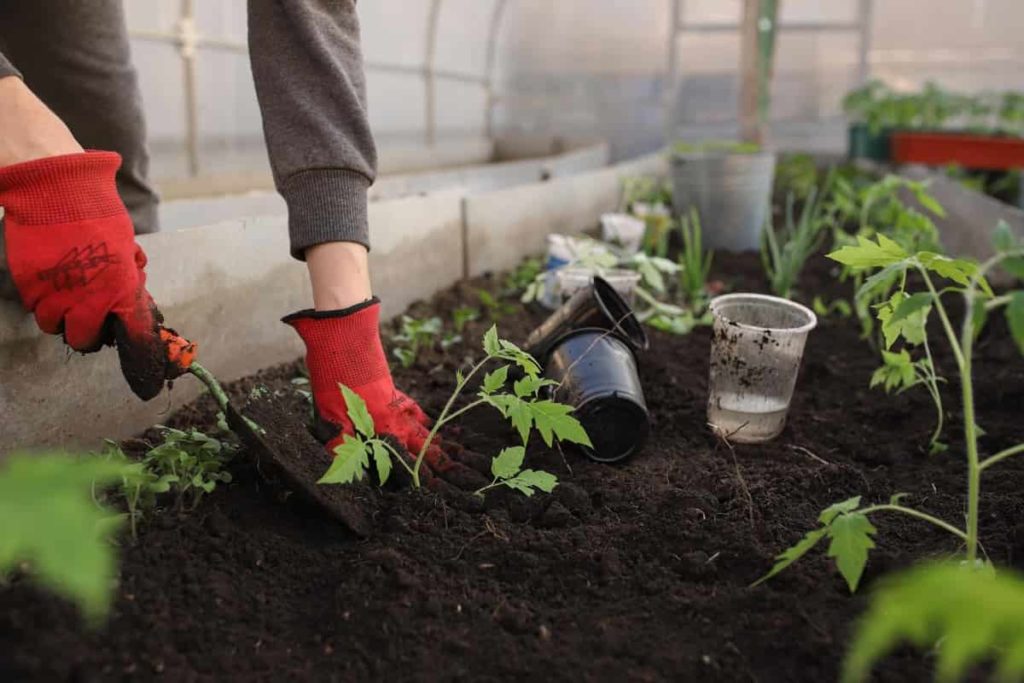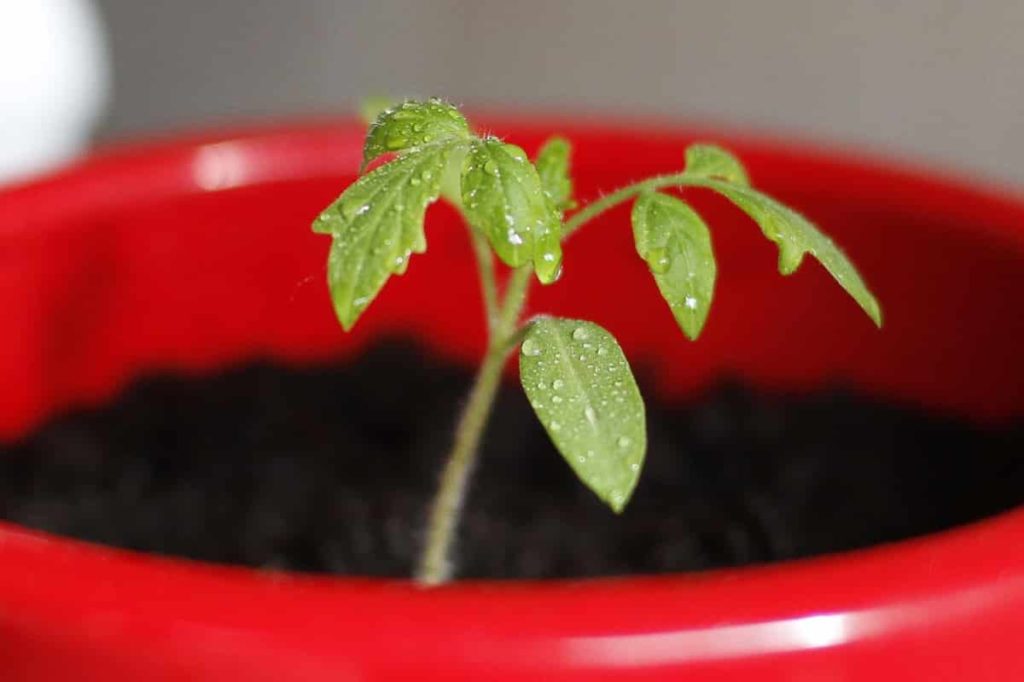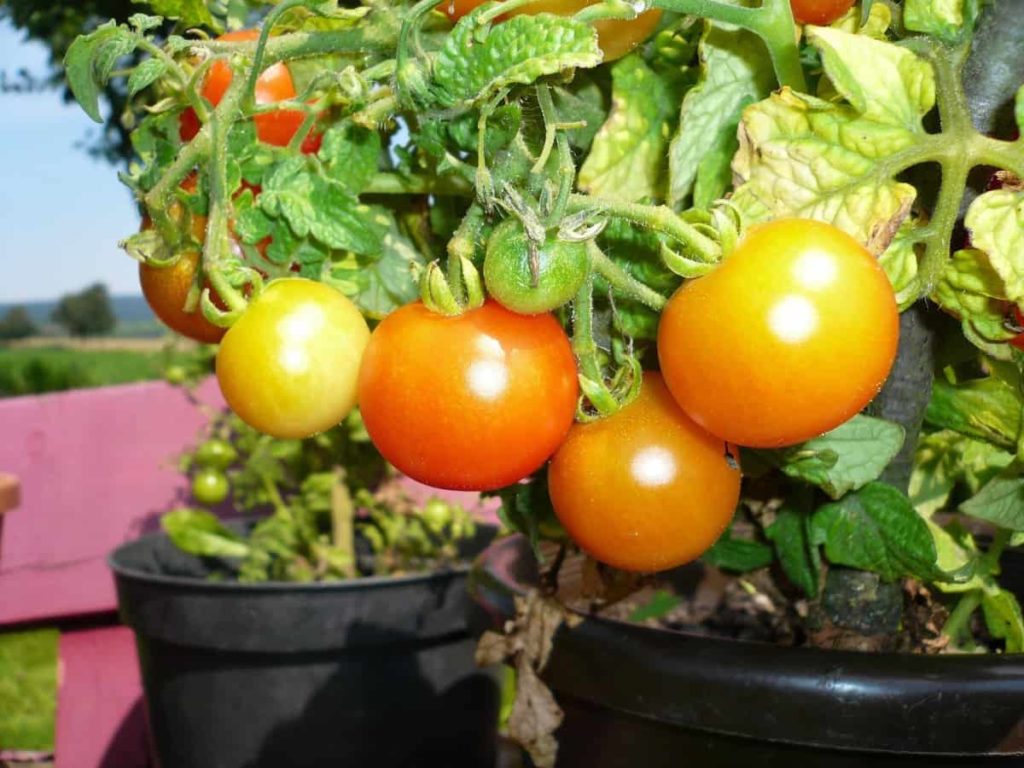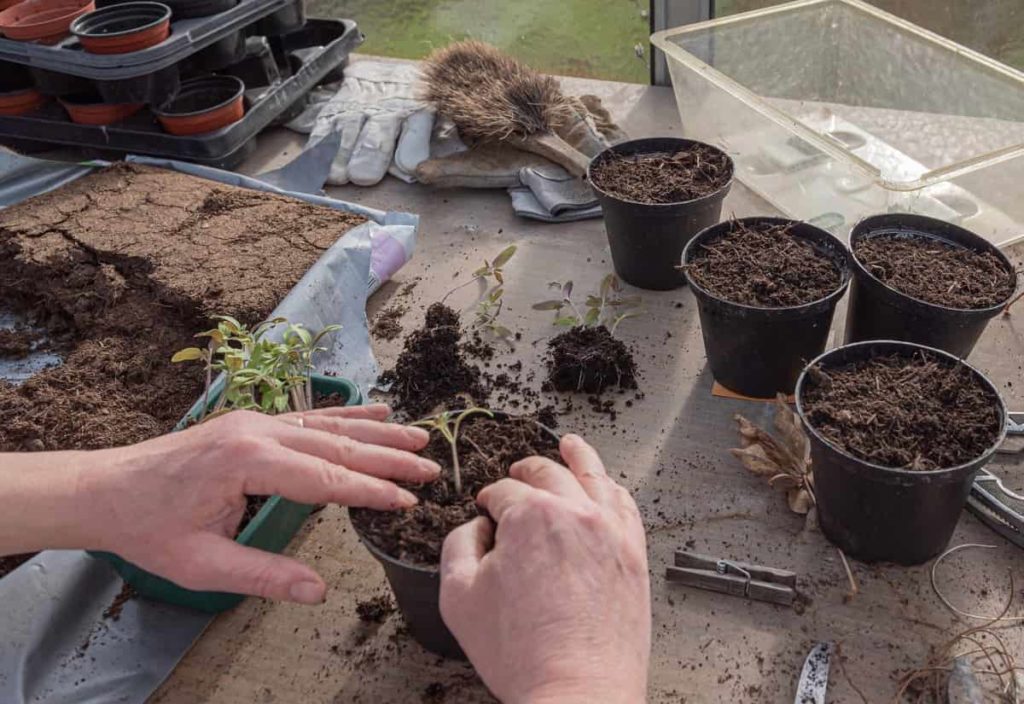You can’t beat the taste of home-grown Tomatoes straight from the vine, and they’re so easy to sow and grow. The trick to growing great-tasting Tomatoes is to choose the best varieties, start plants properly, and control problems before they happen. No one compares to the juicy taste of red, ripe Tomatoes straight out of the garden. These enjoyable fruits not only taste great but are pretty easy to grow. Tomatoes can grow in different conditions except in extreme colds, and they don’t require much space.

How to grow Tomatoes from seeds
How much time does it take Tomatoes to grow from seed?
- Growing Tomatoes from seeds are not difficult, but there are some things to be aware of.
- Tomato harvesting takes more than 60 days to 100 days, depending on the variety. Due to their relatively long growing season requirements (and late planting date), most gardeners do small starter plants or transplants instead of seeds after the spring season warms up.
- It takes about 25 to 60 days for your Tomatoes to prepare after they have flowered, depending on the size entirely. Small Tomato varieties take 25 to 30 days, while large Tomatoes take 45 to 60 days.
When should I start Tomato seeds?
- Growing up from seeds indoors is one way to start your garden. Another option is to sow seeds directly out into the soil. Thus, seeding is called direct sowing, and it is a simple process that has excellent results. Tomatoes are warm-weather plants that need enough sun to thrive and grow best at temperatures between 21 and 24°C.
- If you have a warm climate with a long growing season, you can plant Tomato seeds directly into the ground. For a cool climate, you should start Tomato seeds indoors and transplant the seedlings outside later.
- The perfect time to sow Tomato seeds is from the middle of March to early April. Plants should be large and hard enough to withstand the outdoor weather until the weather warms in June and July. When the time is right, sow high-quality Tomato seeds in pots. You can plant Tomato seeds at any time in the spring.
How do you quick start Tomato seeds?
- Wet the paper towel to germinate Tomato seeds on the paper towel until it’s moist (not wet). Then spread the Tomato seeds so that they are separated. Be sure to place the paper towel and seeds in a warm place, to encourage faster growth and higher growth rates.
- Before planting seeds, you should soak the seeds in water for 24 to 48 hours. Too much soaking and seeds will sink in the water and start to rot.
- Tomato seeds are kept at warm room temperature and sprayed with water twice daily should sprout within a week. As the seedlings break the surface, transfer them to bright light. A full-spectrum grow light is ideal, but a sunny window is also best.
- Tomato seeds usually grow in 5 to 10 days if given the best conditions. You will find that the seeds have grown as soon as the green plant emerges from the growing medium. The growth rate for a particular packet of Tomato seeds depends on the source and age of the seed.
In case you missed it: How To Grow Tomatoes At Home – A Full Guide

How often should I water Tomato seeds?
- Tomatoes need warmth and light. Tomato seeds are kept at warm room temperature and sprayed with water twice daily should sprout within a week. As the seedlings break the surface, transfer them to bright light. Too much water and plants get submerged; too little can cause blossom end rot when Tomatoes turn black on the bottoms.
- Tomato plants must be watered daily or every other day unless you have had recent rains. Plants require 1 to 1.5 inches of water per week, but you must water container-grown Tomato plants twice daily.
- Properly watering your Tomato plants is the key to Tomato success. Water newly planted Tomatoes well to ensure that the soil is moist and ideal for growing. Water the plants daily in the morning at the beginning of the growing season. As the temperature increases, you may need to water the Tomato plants twice a day.
What is the secret to growing Tomatoes?
- Tomato plants love the sun, so you’ll get the best results by growing them somewhere with as much direct sunlight as possible. While Tomato plants can live in the sun for 6 hours daily, they will be happiest within 7 to 8 hours. Soil testing will help you determine if there is a lack of nutrients or if the pH level is slightly off.
- If your soil test indicates sub-par nutrient levels, you can buy a formula fortified with these essential nutrients. Apply it once a week, and also consider using transplanted fertilizers to help ease the transition into the ground.
- Drip irrigation systems or soaker hoses deliver consistent moisture to your plants without overdoing it. Remember, constantly water your Tomatoes on the soil surface; this strengthens the root system and prevents leaf disease.
- Mulch will prevent weeds from growing, and weeds can steal many soil nutrients away from your growing veggie plants. Touch each flower gently with your brush as soon as you see that they have bloomed; Gravity will do it on its own, but a little human help can produce even more fruit.
- Leaving old, dead leaves on your plants can drain plant energy. This damaged plant material is also susceptible to producing fungi, which can spread through your plant and weaken. Moving your Tomatoes to a new garden site will reduce the likelihood that the same pathogens will harm them as last year.
How many seeds do you plant in one hole?
- Do not exceed three seeds per hole. If more than one grows, cut the extra on the soil line. This prevents disruption of the seedling’s roots, which you will keep growing while thinning.
- You should plant Tomato seeds about 1/8 inch deep and press slightly on the soil to ensure that the seeds have sufficient contact with the soil. Cover the seeds with plastic wrap to conserve moisture, and place your seeds in a dark, warm spot.
- Tomato plants should not be planted together. Improper distance of Tomatoes will create insufficient root space. As the roots get tangled, neither will Tomatoes get enough nutrients.
How many Tomatoes do you get per plant?
- Growing Tomatoes is easier when you choose varieties that suit your climate and give them proper care. They are also self-fertilizing plants, so you can plant just one Tomato plant and enjoy a good harvest.
- Throughout the growing season, intermediate Tomato varieties will continue to produce, even after the first ripe Tomatoes on the plant begin to ripen.
- On average, the Tomato plant can produce 10 to 30 pounds of Tomatoes. Depending on the size of the Tomato, it can be about 20 to 90 Tomatoes from a plant. When a square foot is grown in the garden, each Tomato plant can typically produce up to 20 pounds, depending on environmental factors.
In case you missed it: Growing Cherry Tomatoes At Home – In India

Should I pick the flowers off my Tomato plants?
- You can pinch the flowers and any Tomato fruit for at least a month after transplanting.
- Remove the flowers until the plants are 12 to 18 inches tall so that the plants can give more energy to the roots. First, remove all leafy suckers under the fruit cluster so that they do not slow down the fruit growth.
- If left untrained, Tomatoes will produce large numbers of flowers with a large mass of leaves, which puts pressure on energy reserves, resulting in poor quality pickings and difficulty to support.
- By plucking flower buds from its young Tomato plants, the plant will focus on producing more leaves and a stronger stem.
What does baking soda do to Tomato plants?
- Baking soda irritates aphids and prevents them from feeding on the plant. Baking soda reduces its acidity level, which gives you Tomatoes that are sweeter than tart.
- When Tomatoes start appearing and are about 1 inch in diameter; sprinkle baking soda around each plant to sweeten them. Repeat this process when Tomatoes are grown about half.
- Apply baking soda spray for Tomatoes every seven to 14 days (or after every rain event) to plants to avoid fungal diseases until moisture levels no longer promote infection. Before spraying, remove any garden mulch around the affected leaves and plants.
Why do you put Epsom salt on Tomatoes?
- Epsom salt spray increases Tomato yield and keeps plants green and bushy.
- The ideal solution ratio is one tablespoon Epsom salt per foot of plant height. If your Tomato plant is two feet tall, you’ll feed it two tablespoons of Epsom salt at least twice a month. Once on the 15th and the other on 30th will be perfect. For other plants, the general rule occurs once every six weeks.
- Make about one teaspoon of Epsom salt solution per liter (quarter gallons) of water in a spray bottle. Wet the leaves on your Tomato plants every two weeks. The leaves will quickly absorb it.
Is it best to grow Tomatoes in pots?
- Tomato plants perform best in loose, rich, and well-drained soil, which means they transplant easily into container gardens, especially more compact detergent Tomatoes or shrub varieties. Indeterminate varieties of Tomatoes that are larger have a more extensive root system and are better planted directly into the ground.
- Tomatoes will not effectively grow indoors unless conditions are similar to an outdoor garden. Plants require eight hours of sunlight daily, and the surrounding temperature is around 22°C. Consider a spot near a window sill or screen door.
- A great advantage of growing Tomatoes in containers is portability; you can move containers to take advantage of the best growing conditions. Containers are especially useful if you don’t have in-ground garden space; containers can be placed on a balcony, porch, patio, driveway, or deck.
What soil do Tomatoes like?
- Tomatoes aren’t too fussy about what type of soil they’re grown in. Like most garden vegetables, they perform well in well-drained, fertile loams with a pH of 5.8 to 7.0. You can add several inches of organic compost or aged animal manure into the upper 4 to 8 inches of soil before planting.
- Tomato plants will grow well in well-drained places that receive full sun most of the day. Added nitrogen can produce lush, vigorous leafy plants but low fruit production. Flavored Tomatoes require loamy soil that is rich in humus.
In case you missed it: Growing Organic Tomatoes From Seeds – At Home, In Balcony, Outdoors, Indoors, Terrace, Backyard

Do Tomato plants regrow every year?
- Tomato plants usually live for a growing season (6-8 months) when grown outdoors, but Tomato plants can survive between 2 and 5 years when nurtured in ideal or controlled growing conditions indoors. Promoting healthy cutting can also extend its life indefinitely.
- As a general rule, Tomato plants do not grow back every year because they cannot withstand frost. In areas that do not experience frost, Tomato plants can live up to 2 years and produce fruit.
- You can grow Tomato plants indoors to keep them alive throughout the year, but indoor Tomato plants are smaller than outdoor plants in the summer and produce fewer crops. You can move the plants indoors from outside for the winter, but they will eventually stop producing fruit.
Why won’t my Tomato seeds germinate?
- Tomato seeds will not sprout when they are too cold, dry, or old.
- If you have problems growing Tomato seeds, the temperature can be a problem. Ideal temperatures for growth are 22 to 26°C. Temperatures below 21°C will cause slower growth, and if the temperature is too low, there can be no growth.
- After planting Tomato seeds, it’s just a matter of waiting for the seeds to germinate. Tomato seeds should grow in one to two weeks. Colder temperatures will give more time to grow, and warmer temperatures will force Tomato seeds to germinate faster.
Are coffee grounds good for Tomato plants?
- Coffee grounds have low levels of nitrogen. Tomato plants require nitrogen at every level of growth but less during the last stage.
- Coffee grounds contain about 2% nitrogen and varying amounts of phosphorus and potassium, which are very important for the growth of Tomato plants. Therefore, adding some coffee grounds to the soil under your Tomato plants introduces the nutrients that plants need to thrive.
- Allow coffee grounds to go to the ground in the fall and decompose in the soil itself. Soil amendment with organic matter such as compost, manure, or coffee ground twice a year.
Do Tomatoes need full sun?
- Tomatoes love sunshine. One position in full sunlight (an average of eight hours a day) gives the best results in most areas, although if you’re in a warmer climate, you can get away with a dappled shed.
- Tomato sunscald is caused by growing conditions, especially direct sunlight or extended periods during severe, scorching weather. More sunlight colors the patches on ripening or green Tomatoes.
- Tomato plants can still produce fruit without direct sunlight, but they will need an artificial light source to grow indoors or in direct sunlight outdoors. Remember that you will always get a better harvest if your Tomato plants get full sunlight.
- When the temperature consistently hits the 35°C range, Tomatoes stop producing red, which means that red fruits can usually ripen in orange instead. When too much heat hangs with days above 37°C and nights over 27°C, most Tomato ripening stops altogether.
Should I remove yellow leaves from Tomato plant?
- Tomatoes that don’t have enough magnesium will produce yellow leaves with green veins. If you’re sure of a lack of magnesium, try a homemade Epsom salt mixture. Mix two tablespoons of Epsom salt with a gallon of water and spray the mixture on the plant.
- With all varieties of Tomatoes, you can remove dead or yellow leaves as long as it’s under this first set of flowers. With fixed varieties of Tomatoes, there is nothing to be gained by removing dead or yellow leaves, or suckers, which grow more on the plant.
- Once your Tomato plants are 12 to 18 inches tall, you can see that some leaves are dying or turning yellow. Removing these leaves is fine as long as they’re below the first set.
In case you missed it: Growing Organic Tomatoes From Seeds – At Home, In Balcony, Outdoors, Indoors, Terrace, Backyard

Is eggshells good for Tomato plants?
- Eggshells add nutrients to growing Tomato plants. It can fertilize the soil and act as mulch. In addition, it can be used as a starter pot and added to a compost pile. There are numerous benefits of using egg shells on your plants. Eggshells contain various nutrients, including calcium, which help promote healthy growth in Tomato plants. As well as prevent diseases such as blossom end rot.
- Crushed eggshells can be reused as fertilizer for Tomato plants. It can gradually add calcium to the soil, an essential nutrient for Tomato plants. You can sprinkle eggshells before the growing season for better results.
What should not be planted with Tomatoes?
- Potatoes are also in the nightshade family with Tomatoes, so they will compete for the same nutrients and be susceptible to the same diseases. Brassica, including Broccoli, Cabbage, Rutabaga, and Cauliflower, will compete with Tomatoes for nutrients, as both Brassica and Tomatoes are heavy feeders.
What fertilizer is best for Tomatoes?
- You should apply a balanced NPK fertilizer (10-10-10) when planting and switch to phosphorus and potassium-focused fertilizer (5-10-10) as soon as the first flower emerges. Be careful when fertilizing; you should not over-fertilize.
- The hand thinning of Tomato at the end of the truss ensures a more uniform size, larger fruit. Using growth regulators such as auxin on anthesis can stimulate fruit sets and increase fruit size, especially in low light and low-temperature conditions.
- While planting, boost Tomatoes quickly by working a little fertilizer in the soil in the planting hole so that there is easy access to the roots. Try adding blood meal, bone meal, worm castings, and powdered eggshells while planting.
Do Tomatoes regrow once picked?
- Tomatoes can grow back after picking during the regular picking season. However, your Tomato plants probably won’t survive in winter, so your plant won’t continue to produce year after year.
- They usually produce only one crop during a season, with all the fruits ripening within a week or two. For this reason, unspecified varieties of Tomatoes are better if you want to preserve all your yield simultaneously.
In case you missed it: Growing Roma Tomatoes In Pots – From Seeds At Home

Why don’t my Tomatoes get big?
- Lack of water due to drought or improper maintenance is why Tomatoes do not grow fruit. The soil should be constantly moist, or plants may show signs of stress such as wilting, leaf drops, or very small Tomatoes.
- For the largest possible Tomato, give your plants plenty of space. They need space to grow and spread. Two feet of space between rows is usually recommended, but for really large Tomatoes, try and spread them further.
Conclusion
The Tomato plant is the most popular summer garden plant. These warm-season plants require a lot of sun, heat, and water to be productive, and accordingly, their harvest time is mainly in summer and early autumn. Different varieties of Tomatoes require different lengths of time to produce their yields.
- How to Grow Hibiscus from Flower
- Plantation Ideas for Home Decoration: A Beginners Guide
- Flower Garden Designs and Layouts for Beginners
- Planting and Spacing Techniques in Papaya: A Beginner’s Guide
- Growing Gold: Essential Techniques for Planting Pineapples
- How to Make Kalanchoe Plant Bushy: Home Remedies and Solutions
- 11 Reasons Why Your Gardenia is Not Blooming: Home Remedies and Solutions
- Eco Elegance: The Guide to Designing a Drought-Tolerant Landscape
- Gardening on a Slope: Strategies for Hillside Landscaping
- Nourish and Flourish: Top Organic Mulches for Thriving House Plants
- Everything You Want to Know about Indian Mogra Flower: Discover Uses and Growing
- Green Thumb Success: Expert Tips for Cultivating Greenhouse Pumpkins All Year Round
- Maximize Growth & Flavor: The Ultimate Guide to Companion Planting in Herb Gardens
- How to Control Rhododendron Problems Naturally: Home Remedies and Organic Ways to Fix Them
- Natural Magic: The Remarkable Benefits of Cinnamon for Plants
- Best Steps to Revive Dying Tulip with Natural and Organic Treatment
- 10 Reasons Why Your Angel Trumpet is Not Blooming: Remedies and Treatment
- How to Fix Periwinkle Leaf and Flower-Related Problems: Natural Remedies and Solutions
- How to Fix Zinnias Leaf and Flower Problems: Discover Natural and Home Remedies
- Organic Steps to Induce Lemon Tree Flowers: A Comprehensive Guide
- Bloom Booster: Crafting the Perfect Homemade Bougainvillea Fertilizer
- Optimizing Growth: A Guide to Applying NPK Fertilizer for Potted Plants
- 10 Best Homemade Fertilizers for Rubber Plant: DIY Recipes and Application Method
- How to Boost Female Pumpkin Flowers: Effective Steps for More Flowers and High Yields
- Transform Your Indoor Garden: Top Benefits of Pink Salt for Houseplants
- 10 Best Homemade Fertilizers for Peacock Plants (Calathea): Easy DIY Guide
- Unlock Blooms: 9 Reasons Why Your Potted Chrysanthemum is Not Blooming
- 8 Reasons Why Your Potted Hibiscus is Not Blooming: Fix it with Simple Solutions
- Unlock Blooms: 9 Key Reasons Your Potted Frangipani Won’t Flower
- 10 Reasons Why Is My Ice Plant Not Blooming: Remedies and Treatment
- 10 Reasons Why My Potted Hydrangea Not Blooming: Treatment and Remedies
- 10 Reasons Why is My Wisteria Not Blooming: Remedies and Treatment
- 10 Reasons Why is My Goldfish Plant Not Blooming: Remedies and Treatment
- Maximize Your Space: Ultimate Guide to Balcony Gardening with Grow Bags
- 10 Reasons Why Your Iris is Not Blooming: Remedies and Treatment
- 10 Reasons Why Your Anthurium Plant is Not Blooming: Treatment and Remedies